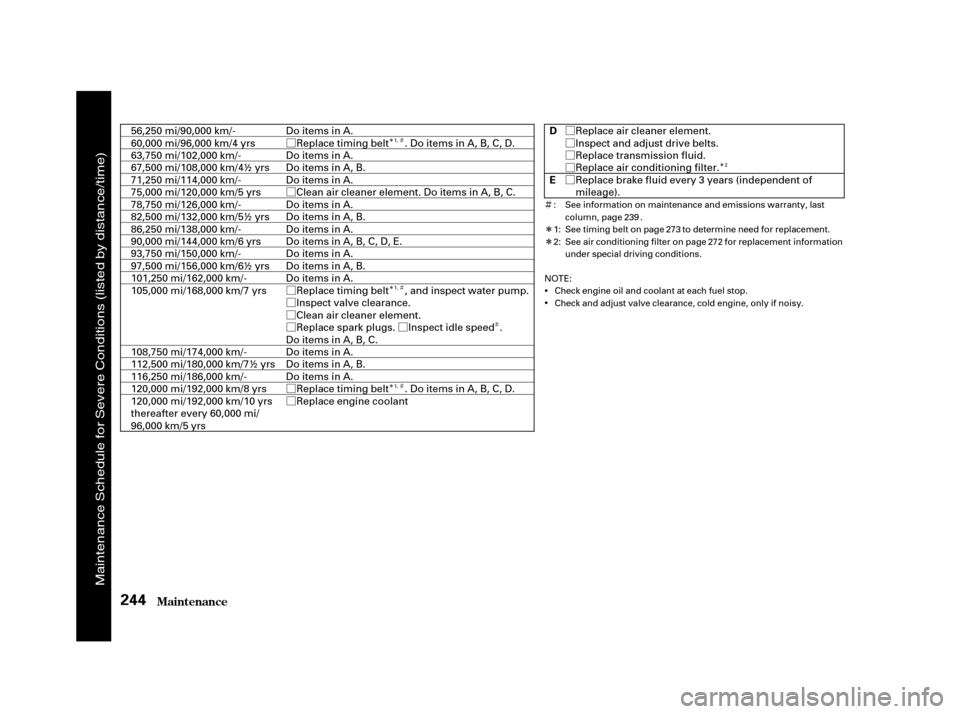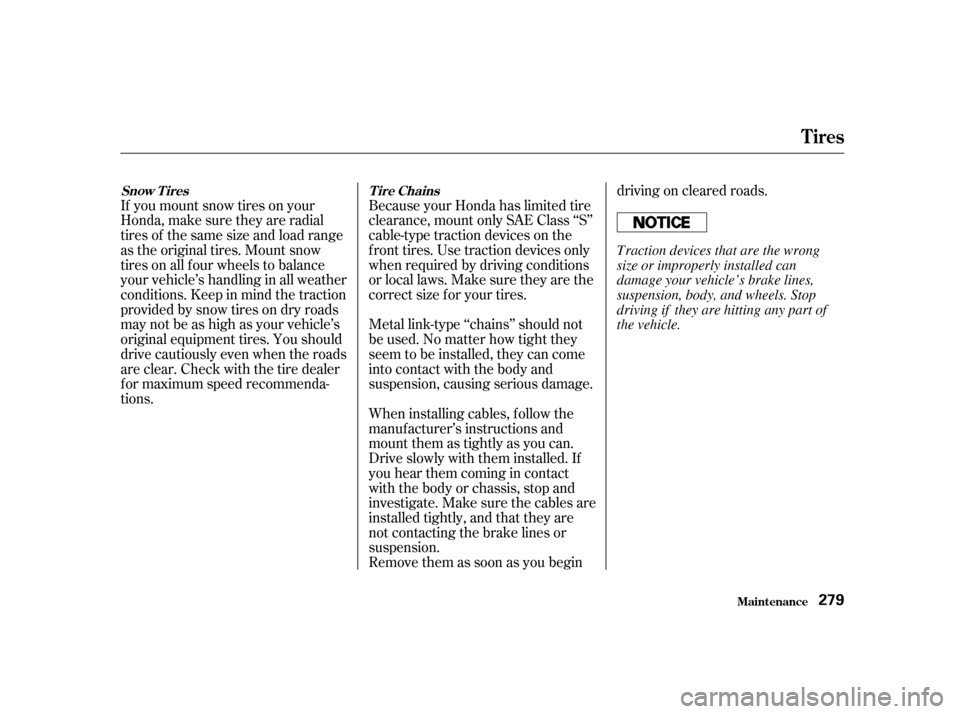Page 243 of 363

�Ø �Ø�Ø�Ø�Ø
�Ø �Ø �Ø �Ø�Ø�Ø�Ø �Ø �Ø �Î
�Î�Ì �Î�Ì
�Ì
�Î�Ì �Ì �Î �Î
Maint enance
244 D E
Check engine oil and coolant at each fuel stop.
Check and adjust valve clearance, cold engine, only if noisy. See air conditioning filter on page for replacement information
under special driving conditions.
See timing belt on page to determine need for replacement.
See information on maintenance and emissions warranty, last
column, page .
: 1: 2:
NOTE: 239
273
272
Replace air cleaner element.
Inspect and adjust drive belts.
Replace transmission fluid.
Replace air conditioning filter.
Replace brake fluid every 3 years (independent ofmileage).
56,250 mi/90,000 km/-
60,000 mi/96,000 km/4 yrs
63,750 mi/102,000 km/-
67,500 mi/108,000 km/4½ yrs
71,250 mi/114,000 km/-
75,000 mi/120,000 km/5 yrs
78,750 mi/126,000 km/-
82,500 mi/132,000 km/5½ yrs
86,250 mi/138,000 km/-
90,000 mi/144,000 km/6 yrs
93,750 mi/150,000 km/-
97,500 mi/156,000 km/6½ yrs
101,250 mi/162,000 km/-
105,000 mi/168,000 km/7 yrs
108,750 mi/174,000 km/-
112,500 mi/180,000 km/7½ yrs
116,250 mi/186,000 km/-
120,000 mi/192,000 km/8 yrs
120,000 mi/192,000 km/10 yrs
thereafter every 60,000 mi/
96,000 km/5 yrs Do items in A.
Replace timing belt . Do items in A, B, C, D.
Do items in A.
Do items in A, B.
Do items in A. Clean air cleaner element. Do items in A, B, C.
Do items in A.
Do items in A, B.
Do items in A.
DoitemsinA,B,C,D,E.
Do items in A.
Do items in A, B.
Do items in A. Replace timing belt , and inspect water pump.
Inspect valve clearance.
Clean air cleaner element.
Replace spark plugs. Inspect idle speed .
DoitemsinA,B,C.
Do items in A.
Do items in A, B.
Do items in A. Replace timing belt . Do items in A, B, C, D.
Replace engine coolant 2
1, 1, 1,
Maintenance Schedule for Severe Conditions (listed by distance/time)
Page 246 of 363
�µ�µ �µ
�µ
�µ
�µ �µ
Youshouldcheckthefollowing
items at the specif ied intervals. If
you are unsure of how to perf orm
any check, turn to the page given.
Engine oil level Check every
time you fill the fuel tank. See
page .
Engine coolant level Check the
radiator reserve tank every time
youfillthefueltank.Seepage .Tires Check the tire pressure
monthly. Examine the tread f or
wear and foreign objects. See page
.
Windshield washer f luid Check
the level in the reservoir monthly.
If weather conditions cause you to
use the washers f requently, check
the reservoir each time you stop
f or f uel. See page .
Automatic transmission Check
the f luid level monthly. See page .
Brakes Check the f luid level
monthly. See page . Lights Check the operation of
the headlights, parking lights,
taillights, high-mount brake light,
turn signals, brake lights, and
license plate light monthly. See
page .
200
201
258
259 260 273
280
Owner Maintenance Checks
Maint enance 247
Page 259 of 363
The f luid level should be between
theMINandMAXmarksontheside
of the reservoir. If the level is at or
below the MIN mark, your brake
system needs attention. Have the
brake system inspected f or leaks or
worn brake pads.
Always use Honda Heavy Duty
Brake Fluid DOT 3. If it is not
available, you should use only DOT 3
or DOT 4 f luid, f rom a sealed
container, as a temporary
replacement. However, the use of
any non-Honda brake fluid can cause
corrosion and decrease the lif e of the
system. Have the brake system
f lushed and ref illed with Honda
Heavy Duty Brake Fluid DOT 3 as
soon as possible.
Check the f luid level in the brake
f luid reservoir monthly.
The brake f luid should be replaced
accordingtothetimeanddistance
recommendations in the mainte-
nance schedule.
Brake f luid marked DOT 5 is not
compatible with your vehicle’s
braking system and can cause
extensive damage.Brake System
Maint enance
Brake Fluid
260
MMAAXX
MMIINN
Page 278 of 363

If you mount snow tires on your
Honda, make sure they are radial
tires of the same size and load range
as the original tires. Mount snow
tiresonallfourwheelstobalance
your vehicle’s handling in all weather
conditions. Keep in mind the traction
provided by snow tires on dry roads
may not be as high as your vehicle’s
original equipment tires. You should
drive cautiously even when the roads
areclear.Checkwiththetiredealer
f or maximum speed recommenda-
tions.Metal link-type ‘‘chains’’ should not
be used. No matter how tight they
seem to be installed, they can come
into contact with the body and
suspension, causing serious damage.
When installing cables, f ollow the
manuf acturer’s instructions and
mount them as tightly as you can.
Drive slowly with them installed. If
youhearthemcomingincontact
with the body or chassis, stop and
investigate. Make sure the cables are
installed tightly, and that they are
not contacting the brake lines or
suspension.
Remove them as soon as you begindriving on cleared roads.
Because your Honda has limited tire
clearance, mount only SAE Class ‘‘S’’
cable-type traction devices on the
front tires. Use traction devices only
when required by driving conditions
or local laws. Make sure they are the
correct size f or your tires.
Snow T ires T ire Chains
Tires
Maint enance 279
Traction devices that are the wrong
size or improperly installed can
damage your vehicle’s brake lines,
suspension, body, and wheels. Stop
driving if they are hitting any part of
the vehicle.
Page 280 of 363
Check the f ollowing:Headlights (low and high beam)
Parking lights
Taillights
Brake lights
High-mount brake light
Turn signals
Back-up lights
Hazard light f unction
License plate light
Side marker lights
Daytime running lights
(Canadian models)
If youfindanybulbsareburnedout,
replace them as soon as possible.
Refer to the chart on page to
determinewhattypeof replacement
bulb is needed. 335
Lights
Maint enance
281
HHIIGGHH--MMOOUUNNTTBBRRAAKKEELLIIGGHHTTSSTTOOPP//TTAAIILLLLIIGGHHTTSS//SSIIDDEEMMAARRKKEERRLLIIGGHHTTSS
BBAACCKK--UUPPLLIIGGHHTTTTUURRNNSSIIGGNNAALLLLIIGGHHTT
TTAAIILLLLIIGGHHTT
LLIICCEENNSSEEPPLLAATTEELLIIGGHHTT
Page 285 of 363
Pull the bulb straight out of its
socket.
Push the new bulb straight into
the socket until it bottoms.
Insert the socket back into the
light assembly. Turn it clockwise
to lock it in place.
Testthelightstomakesurethe
new bulb is working.
Reinstall the taillight cover.Place a cloth on the middle edge
of a part of the lens on the
passenger’s side. Remove a part of
the lens by caref ully prying on its
edge with a small f lat-tipped
screwdriver.
Use a Phillips-head screwdriver to
remove the screw under the lens.Pull the light assembly out of the
tailgate.
Remove the socket f rom the light
assembly by turning it one-quarter
turn counterclockwise.
Pull the bulb straight out of its
socket.
Push the new bulb straight into
the socket until it bottoms.
1. 2.
3.
4. 5. 6. 7.
4. 5.
Lights
Maint enanceReplacing a High-mount Brake
Light Bulb
286
SSCCRREEWW
Page 290 of 363

If you need to park your vehicle f or
an extended period (more than one
month), there are several things you
should do to prepare it f or storage.
Proper preparation helps prevent
deterioration and makes it easier to
get your vehicle back on the road. If
possible, store your vehicle indoors.Block the rear wheels.
If the vehicle is to be stored f or a
longer period, it should be
supported on jackstands so the
tires are of f the ground.
Leave one window open slightly (if
the vehicle is being stored
indoors).
Fill the f uel tank.
Change the engine oil and f ilter
(see page ).
Wash and dry the exterior
completely.
Cleantheinterior.Makesurethe
carpeting, floor mats, etc. are
completely dry.
Leave the parking brake off. Put
the transmission in Park. Support the f ront and rear wiper
blade arms with a f olded towel or
ragsotheydonottouchthe
windshield.
Disconnect the battery.
To minimize sticking, apply a
silicone spray lubricant to all door
and tailgate seals. Also, apply a
vehiclebodywaxtothepainted
surfaces that mate with the door
and tailgate seals. Cover the vehicle with a
‘‘breathable’’ cover, one made
f rom a porous material such as
cotton. Nonporous materials, such
as plastic sheeting, trap moisture,
which can damage the paint.
If possible, run the engine f or a
while periodically (pref erably once
amonth).
If you store your vehicle f or 12
months or longer, have your Honda
dealer perf orm the inspections called
f or in the 24 months/30,000 miles
(48,000 km) maintenance schedule
(Normal Conditions) as soon as you
take it out of storage (see page ).
The replacements called f or in the
maintenance schedule are not
needed unless the vehicle has
actually reached that time or mileage.
251
240
St oring Your Vehicle
Maint enance291
Page 300 of 363

This section covers the more-
common problems that motorists
experience with their vehicles. It
gives you inf ormation about how to
safely evaluate the problem and what
to do to correct it. If the problem has
stranded you on the side of the road,
you may be able to get going again.
If not, you will also f ind instructions
on getting your vehicle towed.......................
Compact Spare Tire . 302
....................
Changing a Flat Tire . 303
..........
If Your Engine Won’t Start . 312
Nothing Happens or theStarter Motor Operates ........................
Very Slowly . 312
The Starter Operates ................................
Normally . 313
................................
Jump Starting . 313
............
If Your Engine Overheats . 315
.........
Low Oil Pressure Indicator . 318
..........
Charging System Indicator . 319
.......
Malf unction Indicator Lamp . 320
.......................
Readiness Codes . 321
...............
Brake System Indicator . 322
..............................................
Fuses . 323
..........
Checking and Replacing . 324
......................
Emergency Towing . 329
Taking Care of the Unexpected
T aking Care of t he Unexpect ed 301